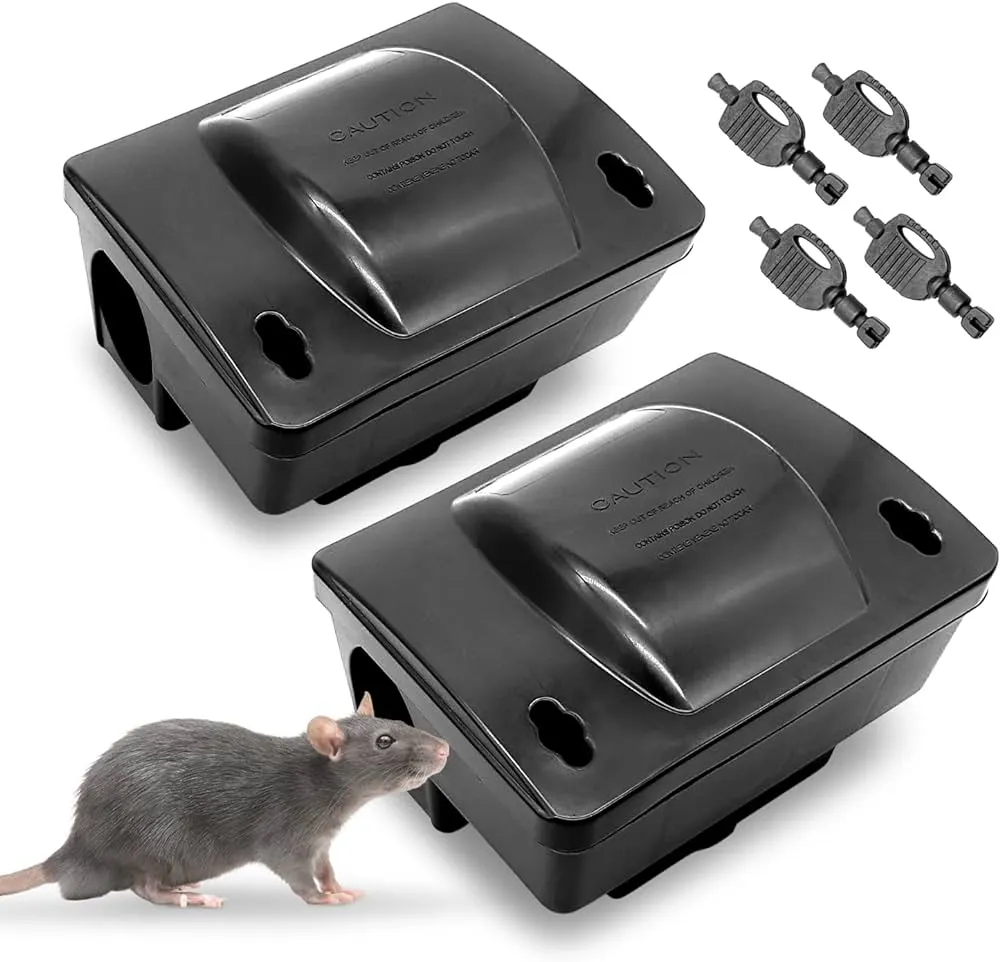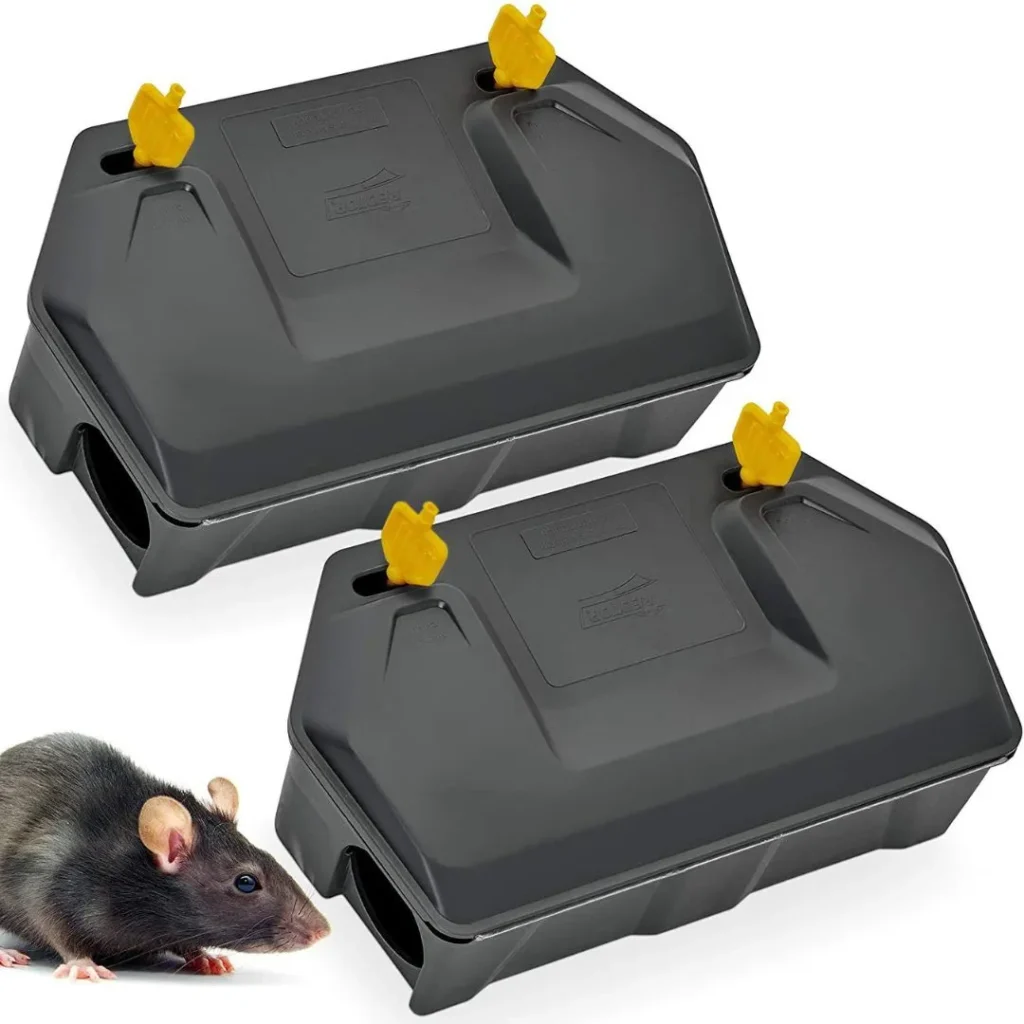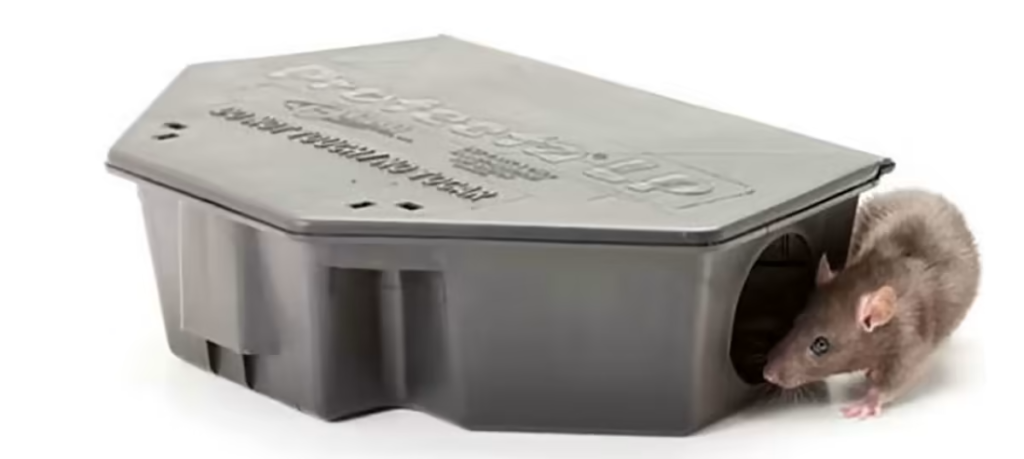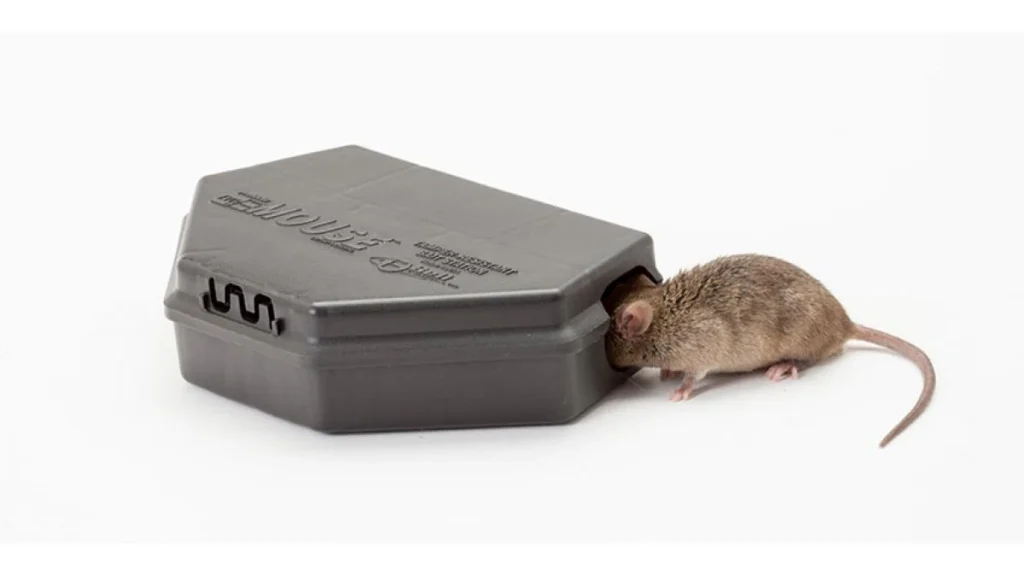
Bait stations for mice are a common solution for homeowners who want to prevent or eliminate a rodent infestation. These small, enclosed containers are designed to hold bait that is toxic to mice, while also keeping the bait out of reach of children and pets. Bait stations are typically constructed from either plastic or metal and are available in a variety of forms and dimensions.
Bait stations work by attracting mice to the container, where they consume the bait inside. The bait is usually a type of poison that is lethal to mice but has little to no effect on humans or pets. Once a mouse has consumed the bait, it will typically die within a few days. Bait stations are frequently positioned in spots where mice are prone to traverse, like adjacent to walls or within room corners.
Bait stations are an effective method for controlling mice infestations. They work by attracting mice to a bait that contains a poison, which the mice will then consume. This method is preferred over traditional mouse traps as it provides increased safety, efficacy, and cleanliness.
There are two main types of bait stations for mice: tamper-resistant and non-tamper-resistant. Tamper-resistant bait stations are engineered to deter children and pets from reaching the toxic substance within. They feature a locking mechanism necessitating a key for access, making them safe to use in homes with small children or pets. Non-tamper-resistant bait stations, on the other hand, do not have a locking mechanism and are not recommended for use in homes with children or pets.

Bait stations work by attracting mice to a bait that contains a poison. The bait is usually made of a food that mice find irresistible, such as peanut butter or cheese. Once the mice consume the bait, they will begin to feel the effects of the poison. The poison will eventually kill the mice, usually within a few days.
It's crucial to highlight that bait stations need to be positioned in areas frequented by mice, like near walls or in corners. Additionally, they should be routinely inspected to ensure that the bait has not been consumed and to replace it if necessary.
Overall, bait stations are a safe and effective method for controlling mice infestations. They should be employed in tandem with other pest control techniques, such as sealing up entry points and keeping food sources out of reach, to ensure that the infestation is completely eradicated.
When it comes to choosing the right bait station for mice, there are a few important factors to consider. Bait stations are a widely adopted and efficient method for managing mice populations, but selecting the right one for your needs can make all the difference.
The first thing to consider is whether you need an indoor or outdoor bait station. Indoor bait stations are designed to be used inside homes, offices, and other buildings. Outdoor bait stations, on the other hand, are designed to be used outside in areas such as gardens, sheds, and garages.
If you are dealing with a mouse infestation inside your home, an indoor bait station is the best option. These stations are usually smaller and more discreet, making them ideal for use in areas where you don't want them to be noticed.
For outdoor use, you'll want to choose a larger, more durable bait station that can withstand the elements. Outdoor bait stations are usually made from heavy-duty materials and are designed to be weather-resistant.

When selecting a bait station, safety should always be a top priority. Bait stations are designed to be tamper-resistant, indicating they are difficult for children and pets to access. However, it's still important to choose a bait station that is safe for your specific situation.
If you have pets or young children, it's crucial to select a bait station that is completely enclosed and cannot be opened without a key. This will help to prevent accidental exposure to the bait inside.
It's also important to choose a bait station that is designed to hold the type of bait you plan to use. Different bait stations are crafted to accommodate various types of bait, therefore, ensure to opt for one that aligns with the bait you've chosen.
Overall, choosing the right bait station for mice can make all the difference in your efforts to control their population. By taking into account factors such as indoor versus outdoor usage and safety considerations, you can select a bait station that is both effective and safe for your specific needs.
When it comes to using bait stations for mice, proper placement is key to achieving maximum efficiency. In this section, we will explore some effective placement strategies that will help you get the most out of your bait stations.

Before placing your bait stations, it is important to identify the areas where mice are most likely to travel. These areas are often near sources of food and water, such as kitchens, pantries, and garbage cans. Inspect for indications of mice activity, such as gnaw marks, droppings, and tracks to help you pinpoint these areas.
Once you have identified the mice traffic areas, place your bait stations in these locations. Be sure to space them out evenly and place them in areas that are easily accessible to mice. This will increase the chances of mice encountering the bait and consuming it.
When placing bait stations, it is important to avoid some common mistakes that can reduce their effectiveness. Here are some suggestions to help you steer clear of these errors:
By following these placement strategies and avoiding common mistakes, you can increase the effectiveness of your bait stations and effectively control mice populations.

When it comes to choosing the appropriate bait for your mice and rat bait stations, there are several options available. Some popular choices include peanut butter, cheese, seeds, and grains. It's important to choose a bait that is attractive to the rodents you are trying to catch. Mice, for example, are attracted to sweet and fatty foods, while rats prefer protein-rich foods.
Another factor to consider is the type of bait station you are using. Some bait stations are designed for use with solid baits, while others are better suited for liquid or gel baits. It's essential to read the manufacturer's instructions and select a bait that is compatible with your bait station.
Proper maintenance and regular refilling of bait stations are critical for their effectiveness. Bait stations should be inspected regularly for damage or signs of tampering. If a bait station is damaged, it should be replaced immediately.
When refilling bait stations, it's important to wear gloves to prevent the transfer of human scent to the bait. Bait should be placed in the bait station in a way that is easily accessible to rodents but not to other animals or children.
It's also important to keep track of when bait stations were last refilled and to replace the bait as needed. Bait that has become moldy or spoiled should be removed and replaced immediately.
By choosing the right bait and maintaining and refilling bait stations regularly, homeowners can effectively control rodent populations in and around their homes.
When using bait stations for mice, it is important to take safety precautions to protect both people and non-target species. Here are some tips to help prevent accidental exposure:
Bait stations should always be placed in areas that are inaccessible to children and pets. This can be accomplished by positioning them in elevated areas or employing child-proof locks. Moreover, it's crucial to supervise children and pets when using bait stations to ensure they do not come into contact with them.
Bait stations can be harmful to non-target species such as birds, squirrels, and other small animals. To prevent accidental exposure, it is important to place bait stations in areas where these animals are unlikely to encounter them. Moreover, it's important to dispose of any unused bait properly to prevent animals from inadvertently ingesting it.
When using commercial mouse bait stations, it is important to follow the manufacturer's instructions carefully. This entails using the appropriate amount of bait and positioning the stations in the correct locations. By taking these precautions, you can help ensure that bait stations are effective at controlling mouse populations without harming non-target species.
When it comes to using bait stations for mice, it is important to comply with local regulations. Various states and municipalities may have their own laws and regulations concerning the use of bait stations. Before acquiring and utilizing outdoor mice bait stations, it's crucial to research and comprehend the local regulations to ensure compliance.
Some local regulations may require the use of tamper-resistant bait stations to prevent accidental exposure to children or pets. Others may require the use of specific types of bait or the placement of bait stations in certain areas. Adhering to these regulations is essential to guarantee the safety of humans and animals in the surrounding environment.
In addition to adhering to local regulations, it's important to consider eco-friendly baiting practices. Traditional baiting methods involve the use of toxic chemicals that can harm not only mice but also other animals in the surrounding environment.
Eco-friendly baiting practices involve the use of non-toxic or low-toxicity bait options that are safer for the environment. Some options include using natural predators or deterrents, such as owls or peppermint oil, to control the mouse population.
When using bait stations, it is important to choose options that are eco-friendly and safe for the surrounding environment. This can include using bait stations made from recycled materials or choosing bait options that are non-toxic or low-toxicity.
Overall, it is important to consider both legal and environmental considerations when using bait stations for mice. By complying with local regulations and using eco-friendly baiting practices, individuals can effectively control the mouse population while also protecting the surrounding environment.
One of the most crucial steps in monitoring bait station effectiveness is tracking bait consumption. This involves regularly checking the bait stations to see if the bait has been eaten or not. If the bait has been consumed, it indicates that there is rodent activity in the area. On the other hand, if the bait remains untouched, it may be an indication that the rodents are not attracted to the bait, or there is no rodent activity in the area.
To track bait consumption effectively, it is essential to record the date and time of each inspection, the quantity of bait stations, and the amount of bait consumed. This information can be recorded in a logbook or spreadsheet, making it easier to track changes in rodent activity over time.
Monitoring bait consumption can also help identify when adjustments to the baiting strategy are necessary. For example, if the rodents are not consuming the bait, it may be necessary to switch to a different type of bait or adjust the placement of the bait stations.
It is also important to ensure that the bait stations are being placed in the right areas. Bait stations should be positioned in areas where signs of rodent activity are present, such as droppings or gnaw marks. Additionally, bait stations should be placed in areas that are inaccessible to children and pets.
Regular monitoring and assessment of bait station effectiveness are essential for successful rodent control. By tracking bait consumption and adjusting the baiting strategy as necessary, it is possible to effectively manage rodent populations and prevent infestations.

While DIY bait stations can be effective in controlling mice infestations, there are certain situations where it's best to hire a professional. For instance, if the infestation is severe, or if the mice are resistant to over-the-counter baits, it's recommended to seek professional help.
Another reason to hire a professional is if you're concerned about the safety of using baits around children or pets. Professional exterminators are trained to use bait stations safely and effectively, minimizing the risk of accidental exposure.
When it comes to professional rodent control, Critter Stop is a top choice. We offer commercial and residential mouse removal services, helping you to say goodbye to these critters.
Critter Stop's technicians are highly trained and knowledgeable in mouse removal, and we use the latest techniques and products to ensure a quick and effective solution to your mouse problem. We also provide continuous monitoring and maintenance to deter future infestations.
In addition to their professional bait station services, Critter Stop also provides other pest control services, including insect control and wildlife removal. Contact us at (214) 234-2616 to get more info.
Bait stations for mice are designed to attract mice with bait and trap them inside the station. The bait is usually a type of poison that is toxic to mice but not to humans or pets. The bait stations are typically made of plastic or metal and come in different sizes and shapes. Once a mouse enters the station and eats the bait, it will die within a few days.
The most effective bait stations for mice are those that are tamper-resistant and have a secure locking mechanism to prevent accidental exposure to the bait. There are several types of bait stations available, including snap traps, glue traps, and electronic traps. Snap traps represent the most traditional type of trap and are effective at catching mice. Glue traps are also effective but can be messy and inhumane. Electronic traps are the most humane and effective type of trap, as they kill the mouse quickly and painlessly.
Yes, bait stations for mice can be used both indoors and outdoors. Indoor bait stations are typically smaller and designed should be positioned in areas frequented by mice, such as along walls or in corners. Outdoor bait stations are larger and designed to withstand the elements. They can be placed around the perimeter of a building or in areas where mice are known to travel, like near garbage cans or compost piles. It is important to use the appropriate type of bait and to follow the manufacturer's instructions when using bait stations for mice.
Visit our Critter Library and learn more about our furry friends